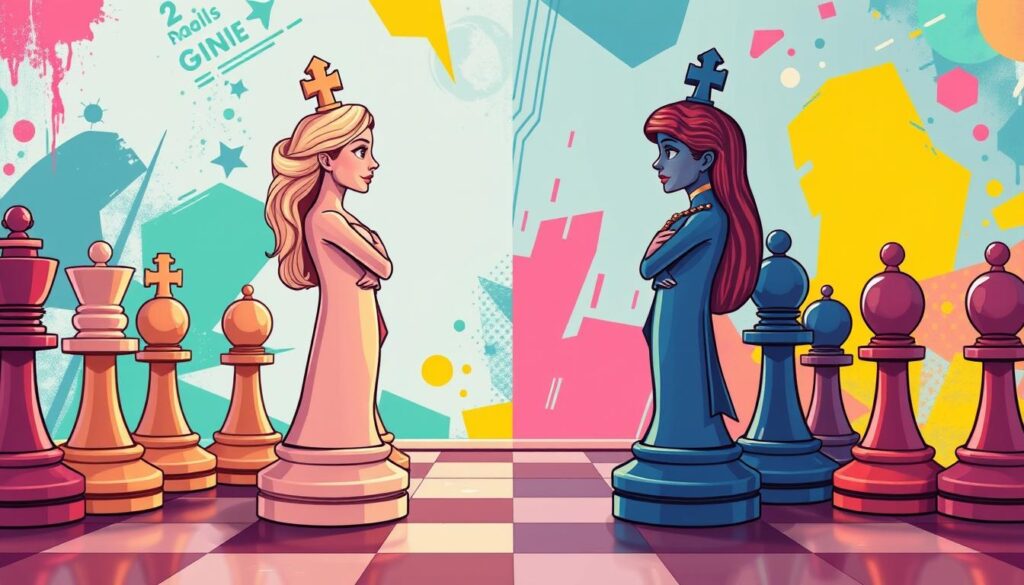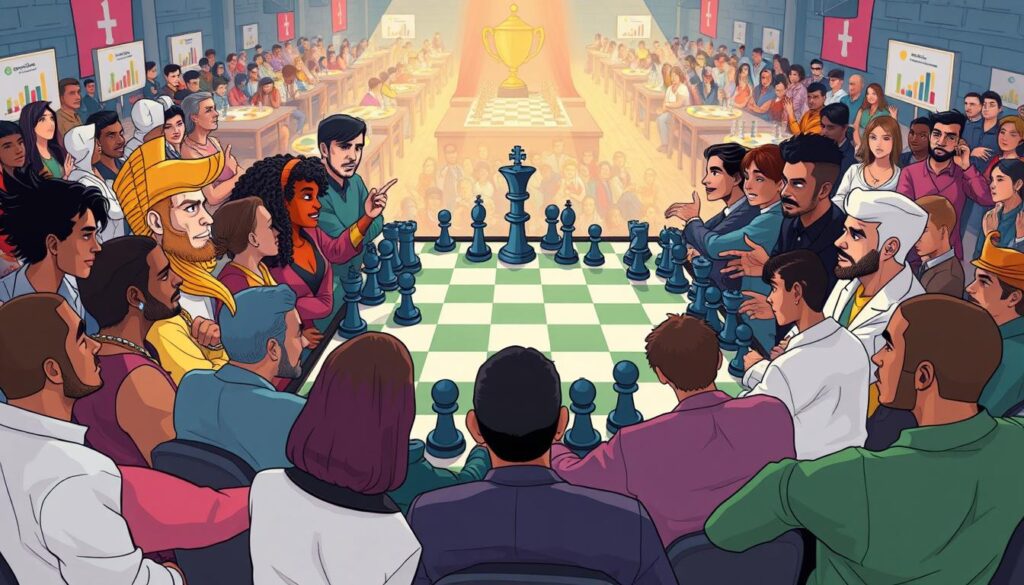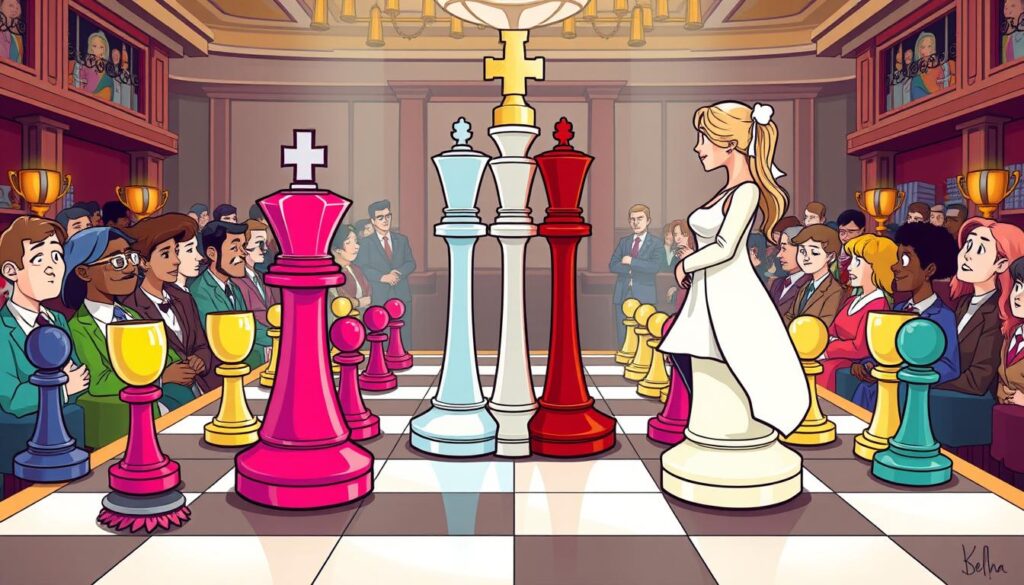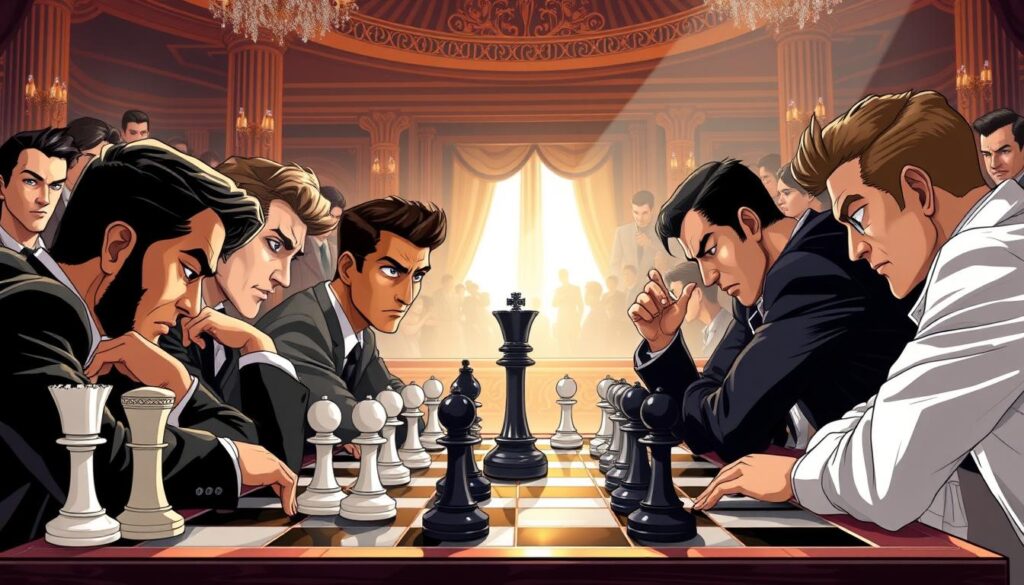Have you ever thought about why chess, a game of pure strategy, has gender categories? With over 605 million adults playing chess worldwide, it’s interesting to think about gender in this game. It brings up questions about competition, skill, and opportunities.
Why is chess divided by gender?
Chess gender categories show a complex mix of skill and society. Right now, women make up just 11% of chess players globally. This shows a big gap in playing this strategic game. Despite chess being all about thinking, the issue of gender is still a big topic for players and fans.
To understand chess gender categories, we need to look at history, psychology, and competition. It’s more than just dividing players into groups. The chess world is still trying to figure out fairness, chances, and how well players do.
Table of Contents
Understanding Chess Gender Categories and Their Purpose

Chess gender divisions are more than just labels. They show how competitive play is shaped by history and society. Chess is a mental game where physical differences shouldn’t count. Yet, we see unique tournament setups because of these factors.
The main reasons for chess categories are:
- Only about 2% of international grandmasters are women
- Women’s chess tournaments aim to increase female participation
- Competitive environments often reveal psychological barriers
Research into women’s chess shows interesting facts. Despite being just as smart, women face big hurdles in professional chess.
| Category | Percentage | Key Observation |
|---|---|---|
| Female Grandmasters | 2.3% | Limited representation at top levels |
| Tournament Participation | 15% | Gradual increase in female involvement |
| Performance Gap | Consistent | Minimal change over decades |
Women’s chess tournaments have many goals. They aim to create supportive spaces, boost participation, and fight stereotypes. The goal is not segregation but empowerment.
These categories help tackle big barriers that stop women from playing top-level chess. They offer special places and recognition. This way, the chess world tries to make things fair and motivate more female players.
The Statistical Reality of Gender Representation in Chess

why is chess divided by gender
The chess world shows a clear gender gap. Only about 15% of chess players are women. This imbalance is seen in both professional and amateur chess.
Let’s look at the current state of chess players:
- Total global chess players: Approximately 605 million adults
- Active FIDE-rated players: 8.2 million
- Female chess players: Significantly underrepresented
Professional chess rankings are even more telling. Among 1,594 global grandmasters, only 35 are women. This means women make up just 2.2% of the top players.
| Chess Player Category | Total Players | Female Representation |
|---|---|---|
| Global Chess Players | 605 Million | Less than 15% |
| FIDE-Rated Players | 8.2 Million | Approximately 10% |
| Grandmasters | 1,594 | 35 (2.2%) |
The gender gap in chess is not just about numbers. It also shows deeper issues like access, encouragement, and cultural views. These have long kept women from fully participating in chess.
Why are There Gender Categories for Chess

Chess has gender categories for many reasons. The chess world faces big challenges in getting more women to play. These challenges go beyond just playing the game.
Today, we see a clear gap in chess:
- Only 11% of FIDE-rated players worldwide are female
- In 2020, just 37 out of 1,722 grandmasters were women
- Women make up about 15% of United States Chess Federation rated players
Women’s chess tournaments are key to fixing this gap. They give female players a chance to grow, feel confident, and break down barriers.
Getting more women into chess is a long journey. There are many reasons for the gap:
- Women have been left out of chess for a long time
- They face mental challenges during games
- They often lack mentors and role models
- People still think chess is only for men
By understanding these issues, chess can become more welcoming. This will help more people, regardless of gender, to play and grow.
To achieve gender balance in chess, we need to keep working, make changes, and support women’s chess efforts.
Male Dominance in Professional Chess: Analysis

why is chess divided by gender:
In professional chess, a clear gender gap is seen. Men lead the top chess rankings, while women make up only two percent of Grandmasters. This imbalance shows deep challenges in the chess world.
Looking closer at gender representation, we find important points:
- Women make up only 2% of Grandmaster-level players worldwide
- In 1990, women were 4% of chess players, now they are 14%
- Major chess competitions have big gender gaps, with 188 male teams and 151 female teams
Why is chess divided by gender:
Research shows the gender gap in chess isn’t about ability. Studies from 2020 found no biological reasons stopping women from reaching top ranks. The real issues seem to be social and cultural, pushing women away from chess.
New efforts like the ChessMom project and National Female Team Initiative are working to change this. They aim to make chess more welcoming for women at every level.
The digital world has also changed chess. Sites like Chess.com and YouTube channels with players like Anna Cramling and the Botez sisters are helping. They inspire more women to play chess.
The Role of Cultural and Social Factors
Cultural influences on chess show deep social challenges. These challenges affect who plays and how they play.
Why is chess separated by Gender:
Gender stereotypes in chess stop many talented women from fully joining the game.
Social factors in chess greatly affect young players, girls in particular. Research shows a big drop in female players around ages 12-13. This is a key time when support from others is very important.
- Societal expectations discourage girls from competitive chess
- Limited female representation in professional tournaments
- Psychological barriers created by gender stereotypes
The chess community is working to change these big challenges. Programs like Chess-in-the-Schools are leading the way. They aim to break down old barriers and make chess more welcoming for everyone.
| Social Factor | Impact on Female Chess Players |
|---|---|
| Parental Support | Critical for continued engagement |
| Peer Network | Influences motivation and skill development |
| Role Models | Provides inspiration and pathway visualization |
By understanding and tackling cultural influences on chess, we can make the game fairer. This way, everyone, no matter their gender, can have a chance to play and succeed.
Notable Women Breaking Barriers in Chess
The chess world has seen amazing female champions who broke down gender barriers. Women grandmasters have shown that chess isn’t just for men. They’ve proven their strategic skills and intelligence.
Pioneering women in chess have made a lasting impact. Judit Polgar is a chess legend. She became a grandmaster at 15, a record at the time. Her career highlights include:
- Reaching the top 10 world chess rankings
- Defeating 11 current or former world champions
- Achieving a peak rating of 2735 in 2005
Hou Yifan is another inspiring figure. She won the Women’s World Championship four times. Her achievements include:
- Winning world championships while attending college
- Stalemating world champion Magnus Carlsen in 2017
- Becoming a prominent representation of women’s chess excellence
The pandemic era brought new chances for women in chess. Online platforms showed off female talent. The Botez sisters, for example, have brought women’s chess to more people. They inspire a new generation of players.
These female chess champions challenge gender stereotypes. They show that intelligence has no gender. Their success encourages young women to take chess seriously.
The Debate Over Separate Gender Categories(Why are there Gender categories for Chess)
Chess is facing a big challenge in making tournaments fair for everyone. The debate is about whether having separate games for men and women helps or hurts women’s chances. Some think making games for everyone could solve old problems.
Research shows interesting things about mixed games. It shows how performance can change:
- When female players don’t know their opponent’s gender, they win about 50% of the time
- But, if they know they’re playing a man, their win rate drops to around 25%
- It seems that mental barriers are bigger than any skill differences
Players like Judit Polgar have pushed against old gender limits. She became a grandmaster at 15, setting records and showing women can reach the top in chess.
| Perspective | Argument |
|---|---|
| Pro-Separate Categories | Provides a supportive space for women’s growth |
| Anti-Separate Categories | Keeps old gender stereotypes alive in chess |
| Neutral Position | Wants a fair way to show everyone’s skills |
A 2023 study from New York University found big biases from parents and coaches. It shows that old ways of thinking hold women back in chess. The chess world is still trying to make games fair for all.
Conclusion
The world of chess is changing fast, with a big push for gender equality. We’re seeing more girls playing chess, like the 39% increase in Northern California. Also, six female players made it into the US Chess’s Under-21 rankings.
Chess is becoming more open to everyone, thanks to groups like FEMchess. They held a big tournament with 89 girls, showing how chess is welcoming more women. Today, 20% of chess players are women, up from 6% in 2000.
You can help make chess more inclusive. Support programs that give everyone a chance to play. FIDE Women’s Commission and local groups are working hard to get more girls into chess.
The future of chess looks bright. With your help, the next generation will have a fair and exciting game. Let’s keep pushing for equality in chess. and this is why is chess divided by gender.
FAQ
Why are there gender categories for chess?
Chess has gender categories to help women compete at high levels. This is because of past gaps in participation. Women can play in both open and women’s tournaments. This encourages more women to play in a field mostly dominated by men.
Can women compete in open chess tournaments?
Yes, women can compete in open tournaments. There are no rules stopping them. Some, like Judit Polgar, have even reached the top levels.
How many female chess grandmasters are there?
There are about 35 female grandmasters worldwide. This is compared to over 1,500 total grandmasters. This shows a big gap in competitive chess.
Why do so few women reach top chess rankings?
Many factors contribute to this, like cultural barriers and fewer players. Only about 11% of FIDE-rated players are women. This makes it hard for women to reach the top.
Are men naturally better at chess?
No, there’s no proof that biology makes one gender better at chess. The gap is mainly due to fewer women playing and cultural barriers.
When did women first compete in professional chess?
Women’s World Chess Championship started in 1927. Vera Menchik was the first champion. Nona Gaprindashvile became the first female Grandmaster in 1978.
Do gender categories help or hinder women in chess?
This is a topic of debate. Some say separate categories give women chances to shine. Others think they keep women out of main competitions.
How can the chess community improve gender representation?
To improve, we need to support young female players more. We should tackle cultural biases and offer equal training. Also, we should celebrate women’s success through mentorship and recognition.

















